#daspletosaurus wilsoni
Explore tagged Tumblr posts
Text



Sisyphus, holotype of Daspletosaurus wilsoni is now on display at Badlands Dinosaur Museum! The cranial elements will be added after they undergo CT scanning.
#paleontology#paleoblr#palaeontology#palaeoblr#fossils#dinosaurs#daspletosaurus#daspletosaurus wilsoni#prehistoric#Sisyphus#science#art#tyrannosaur#theropod#cretaceous#judith river formation#museum#not prep
253 notes
·
View notes
Text

From the same talent that produced this awesome Raptorex juvenile Tarbosaurus model! Printed, painted, and mounted by Steve Clawson.
[3D reconstruction] [Daspletosaurus wilsoni]
On arrive bientôt au bout du travail. Impression 3d à l'échelle 1:4 pour vérifier l'articulation de la mâchoire inférieure et l'inclinaison des dents du prémaxillaire.
Soon my work will be finished. 3D printing at 1:4 scale to check the articulation of the lower jaw and the inclination of the premaxillary teeth. Facebook page
78 notes
·
View notes
Photo
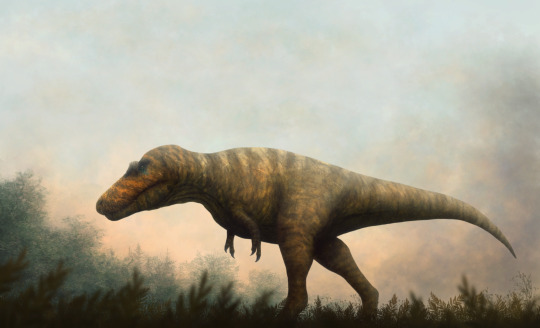
Daspletosaurus wilsoni is a tyrannosaurid described in 2022 from the Judith River Formation in Montana (USA).
#my art#paleoart#daspletosaurus#wilsoni#d.wilsoni#theropod#carnivore#tyrannosaur#tyrannosaurid#dinosaur#extinct#animal#nature#sciart#cretaceous#montana#usa#judith river formation#prehistoric
83 notes
·
View notes
Text
Archovember 2024 Day 3 - Gorgosaurus libratus
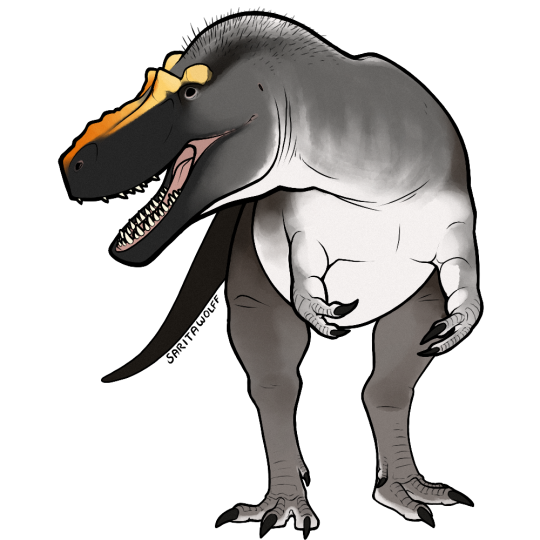
The apex predator of Western North America during the Late Cretaceous was Gorgosaurus libratus. Found so far in Alberta, Canada and Montana, USA, it lived several million years before Tyrannosaurus rex would appear. While it was a tyrannosaurid, it was more closely related to Albertosaurus, so much so that some scientists consider it to be another species of Albertosaurus. Gorgosaurus is the most numerous tyrannosaurid in the fossil record, known from dozens of specimens. This abundance of fossils has allowed paleontologists to investigate Gorgosaurus’ ontogeny, life history and many other aspects of its biology. For example, in 2023, a 5-7 year old juvenile Gorgosaurus was discovered with stomach contents consisting of two intact Citipes juveniles about a year old. This showed that younger Gorgosaurus’ were mostly eating prey much smaller than them, and were probably not hunting in packs, as the meal would not have been large enough to share. That being said, only the remains of the hindlimbs and caudal vertebrae of the juvenile Citipes were present, suggesting that this Gorgosaurus may have had a preference for the muscular hindlimbs. Many Gorgosaurus specimens also preserve evidence of facial scars, a result of intraspecies facebiting.
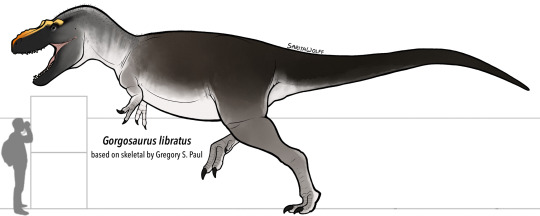
Gorgosaurus would have lived on the coastal plain along the western edge of the Western Interior Seaway, an inland sea which divided North America in half during the Late Cretaceous. The area was subtropical with periods of drought. Conifers would have dominated the forests, while the underbrush consisted of ferns, tree ferns and angiosperms. Gorgosaurus is best known from the Dinosaur Park Formation. Here, it would have lived alongside another apex predator: Daspletosaurus wilsoni. While these tyrannosaurids were roughly the same size, they may have preferred different types of prey, allowing them to coexist without too much competition. And there was a wide diversity of prey here, from many of the most famous ornithopods like Parasaurolophus walkeri, Corythosaurus casuarius, Gryposaurus notabilis, and Lambeosaurus lambei, to beloved ceratopsians like Styracosaurus albertensis, Centrosaurus apertus, Chasmosaurus belli, Spinops sternbergorum, and Vagaceratops irvinensis. There were also ankylosaurs like Anodontosaurus inceptus, Dyoplosaurus acutosquameus, Edmontonia rugosidens, Euoplocephalus tutus, Panoplosaurus mirus, Platypelta coombsi, and Scolosaurus. Pachycephalosaurids included Foraminacephale and Stegoceras validum. Gorgosaurus also shared space with other, smaller theropods, like the ornithomimids Ornithomimus and Rativates, caenagnathids like Caenagnathus, Chirostenotes, and Citipes, dromaeosaurids like Dromaeosaurus and Saurornitholestes, and troodontids like Latenivenatrix and Stenonychosaurus. Dinosaurs were not the only animals here, and Gorgosaurus would have also had to share space with the giant azhdarchid pterosaur Cryodrakon, as well as alligatoroids like Albertochampsa and Leidyosuchus, and choristoderes like Champsosaurus. Gorgosaurus is also known from the Two Medicine Formation and Judith River Formation.
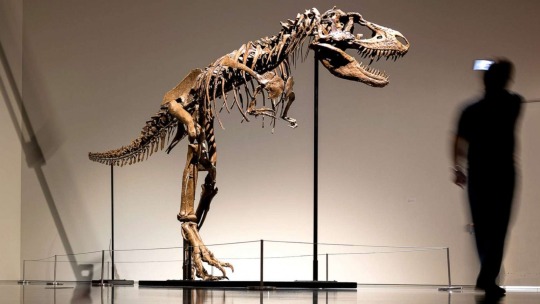
This art may be used for educational purposes, with credit, but please contact me first for permission before using my art. I would like to know where and how it is being used. If you don’t have something to add that was not already addressed in this caption, please do not repost this art. Thank you!
#Gorgosaurus libratus#Gorgosaurus#tyrannosaurids#theropods#saurischians#dinosaurs#archosaurs#archosauromorphs#reptiles#Archovember#Archovember2024#Dinovember#Dinovember2024#DrawDinovember#DrawDinovember2024#SaritaDrawsPalaeo#Late Cretaceous#Canada#USA#Dinosaur Park Formation#Two Medicine Formation#Judith River Formation
118 notes
·
View notes
Text
Fossil Friday: Daspletosaurus

Before Tyrannosaurus stomped across Montana, another tyrannosaur ruled the roost: Daspletosaurus. Found in the Two Medicine and the Judith River Formations of Montana as well as the Oldman and Dinosaur Park Formations of Alberta, Daspletosaurus was considered a predecessor of Tyrannosaurus.
There are three recognized species that show a transition from Daspletosaurus to Tyrannosaurus. Neat, right? D. torosus is the most basal of the three species. The next most derived is D. wilsoni with D. horneri as the most derived and closest to Tyrannosaurus. Below is a diagram showing the changes in skull morphology.

Daspletosaurus was discovered in 1921 near Steveville, Alberta by Charles Mortram Sternberg, son of Charles Hazelius Sternberg of which the Sternberg Museum of Natural History in Hays, Kansas is named for. Initially, Sternberg thought it was a new species of Gorgosaurus.
In 1970,Dale Russell described and named the fossil Daspletosaurus torosus which means "muscular frightful lizard". Seems fitting.

Daspletosaurus averaged between 28-30ft (8.5-9 m) in length and was about 7.2 ft (2.2m)at the hip. It also had the longest front limbs in proportion to its body of any tyrannosaurid.

There is evidence that Daspletosaurus lived in social groups. A bonebed in the Two Medicine Formation contains remains of a large adult, a small juvenile and an intermediate- (teenager?) sized individual. It could be taphonomic bias but nothing can be ruled out just yet.

Daspletosaurus lived alongside a wide variety of animals including the famous Maiasaura,

Brachylophosaurus,

Coronosaurus,

Albertaceratops,

and even Gorgosaurus.

During the early Late Cretaceous when Daspletosaurus lived, North America was split into two continents by the Western Interior Seaway.

Daspletosaurus lived in Laramidia to the west mostly in the north central reaches (Gorgosaurus tended to be further north). It lived on a vast floodplain with the seaway to the east and the beginnings of the Rocky Mountains to the west. Volcanic eruptions periodically blanketed the land with ash as well.

Tune in Monday to learn about what Tyrannosaurus did not evolve into. Have a good weekend and fossilize you later!
#paleontology#fossils#fun facts#fossil friday#dinosaur#science#science education#prehistoric#daspletosaurus#montana#alberta
19 notes
·
View notes
Text

"Eyelids of Morning"
Two young Daspletosaurus wilsoni patrol their newly acquired territory.
#animals#zoology#paleoart#reptiles#art#nature#wildlife#paleontology#birds#birds of prey#animal behavior#daspletosaurus#tyrannosauroidea#theropod#morning
183 notes
·
View notes
Text

A dinosaur tooth of an indeterminate tyrannosaurid, either Daspletosaurus sp. or Gorgosaurus libratus from the Judith River Formation in Hill County, Montana, United States. Unfortunately, the vast majority of teeth of Gorgosaurus and Daspletosaurus are indistinguishable from one another. There are currently two species of Daspletosaurus described from this deposit, Daspletosaurus torosus and Daspletosaurus wilsoni. The tooth has an interesting red coloration and pronounced enamel texture. The midline distal serration density is 13/5mm, while the midline mesial serration density appears to be the same, though very worn down, and around 15/5mm towards the base.
#dinosaur#fossils#paleontology#palaeontology#paleo#palaeo#daspletosaurus#gorgosaurus#tyrannosauridae#daspletosaurini#albertosaurinae#theropod#cretaceous#mesozoic#prehistoric#science#paleoblr#ダスプレトサウルス#ゴルゴサウルス#ティラノサウルス科#恐竜#化石#古生物学
9 notes
·
View notes
Text
Daspletosaurus wilsoni. I think I made the head too small unfortunately :(
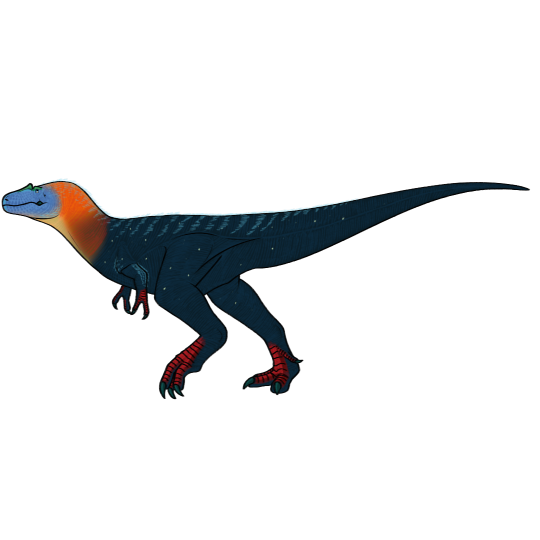
With Hatsune Miku for scale:

13 notes
·
View notes
Text

Last day of the Judith River July challenge month is officially Day 11 (or even 31): Daspletosaurus wilsoni.
#my art#dinosaur#paleoart#myart#dinosaurs#dinosauria#my drawings#sketch pad#theropoda#tyrannosauridae#daspletosaurus#Judith River July#artists on tumblr
9 notes
·
View notes
Text
Re-analysis of a dataset refutes claims of anagenesis within Tyrannosaurus-line tyrannosaurines (Theropoda, Tyrannosauridae)
Published 28th November 2023
Phylogenetic reanalysis of Daspletosaurus wilsoni reveals a cladogenetic Tyrannosaurinae composed of four morphologically and biogeographically distinct clades that are formally defined and diagnosed (Teratophoneini clade and Tyrannosaurini).
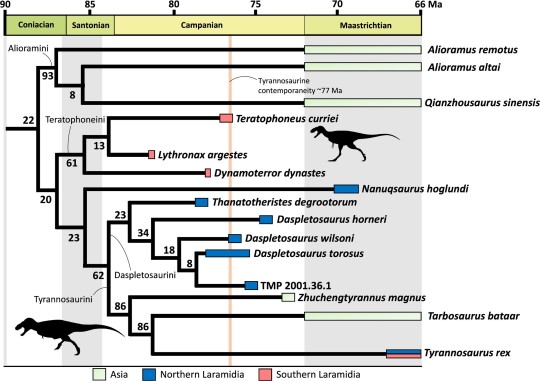
Cladistic analyses strict consensus phylogeny of Tyrannosaurinae

Stratigraphic distribution of the species of Daspletosaurus
Source:
3 notes
·
View notes
Text
Daspletosaurus wilsoni Warshaw & Fowler, 2022 (new species)

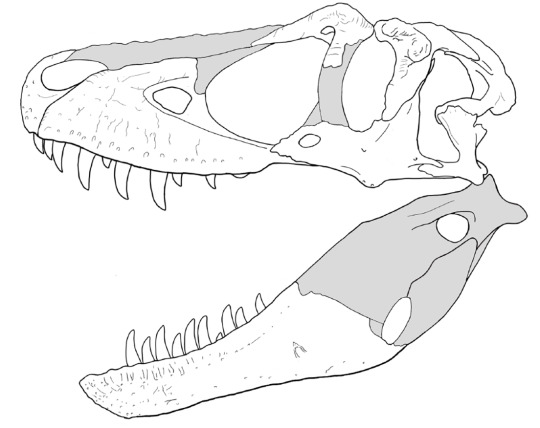
(Maxilla [bone in the upper jaw, top] and reconstructed skull [bottom] of Daspletosaurus wilsoni, with preserved bones in white, from Warshaw and Fowler, 2022)
Meaning of name: wilsoni = for John Wilson [discoverer of the original fossil]
Age: Late Cretaceous (Campanian), probably around 76.5 million years ago
Where found: Judith River Formation, Montana, U.S.A.
How much is known: Partial skeleton of one individual, including a partial skull, some vertebrae, and a foot bone.
Notes: D. wilsoni was a tyrannosaurid theropod, making it a fairly close relative to Tyrannosaurus. Two other species of Daspletosaurus have previously been named, the slightly older D. torosus and the slightly younger D. horneri. D. wilsoni exhibits a mixture of traits seen in the other two species. Combined with its intermediate geologic age, the describers of D. wilsoni suggest that the three named species of Daspletosaurus formed a direct line of descent, with D. wilsoni having descended from D. torosus and given rise to D. horneri.
Reference: Warshaw, E.A. and D.W. Fowler. 2022. A transitional species of Daspletosaurus Russell, 1970 from the Judith River Formation of eastern Montana. PeerJ 10: e14461. doi: 10.7717/peerj.14461
#Palaeoblr#Dinosaurs#Daspletosaurus wilsoni#Late Cretaceous#North America#Tyrannosauroidea#2022#Extinct
79 notes
·
View notes
Text
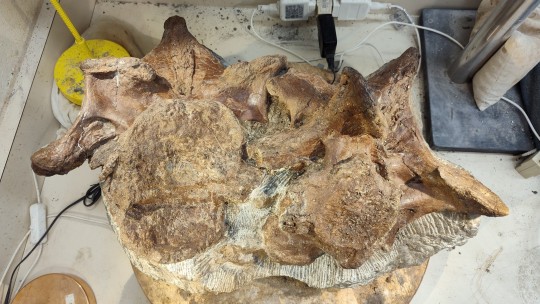

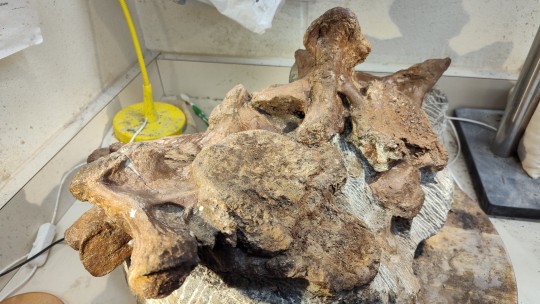
With the completion of the cervical block, the holotype of Daspletosaurus wilsoni has been fully prepared. Approximately 350 hours shared between both Annamarie Fadorsen and I.
#click for higher res#Badlands Dinosaur Museum#Daspletosaurus#paleoblr#palaeoblr#palaeontology#paleontology#fossil#fossils#fossil preparation#dinosaurs#tyrannosaur#fossil prep#Daspletosaurus wilsoni
181 notes
·
View notes
Text
T-Rex'in Korkutucu Akrabası Keşfedildi
T-Rex’in Korkutucu Akrabası Keşfedildi
Yakın zamanda keşfedilen evrimsel bir “kayıp halka” türü, çok büyük ve iyi bilinen bir zincirin çok büyük ve korkutucu bir halkasıydı. Keşfin Daspletosaurus wilsoni türünün Tyrannosaurus Rex’in doğrudan atası olduğuna inanılıyor. Göz çukurunun üzerinde “boynuzcuklar” olarak bilinen bir dizi çıkıntı gibi ayırt edici bir yüz özellikleri koleksiyonuna sahipti. Herkes Kretase Dönemi besin zincirine…
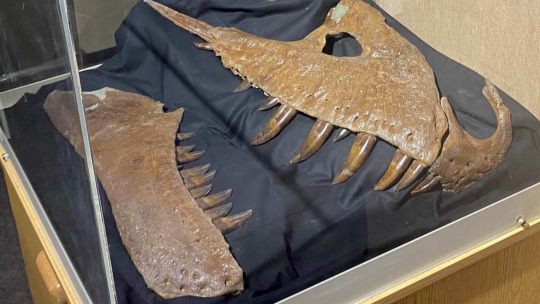
View On WordPress
0 notes
Text
Hóa thạch 76,5 triệu năm tiết lộ tổ tiên của T-rex
Hóa thạch 76,5 triệu năm tiết lộ tổ tiên của T-rex
Các nhà khoa học đã phát hiện ra một loài khủng long ăn thịt chưa từng được biết tới, có thể là tổ tiên của khủng long bạo chúa. Mô phỏng loài khủng long ăn thịt mới có thể là tổ tiên của T-rex. Ảnh: BDM Theo nghiên cứu xuất bản trên tạp chí Paleontology and Evolutionary Science vào cuối tháng 11, loài khủng long mới được đặt tên là Daspletosaurus wilsoni có thể dài từ 8 đến 10 m. Hóa thạch 76,5…
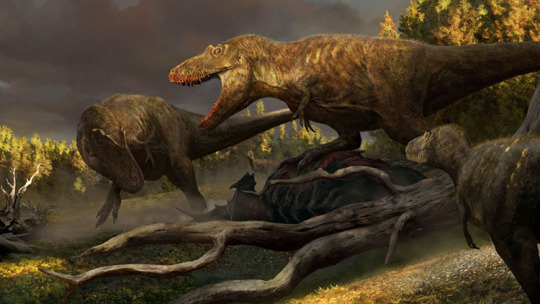
View On WordPress
0 notes
Text
New tyrannosaur fossil discovered may be a “missing link”
New Post has been published on https://petn.ws/iYJD
New tyrannosaur fossil discovered may be a “missing link”
Though Tyrannosaurus rex is considered the “king” of the dinosaurs, the “tyrant lizard” only roamed Earth for about the last two million years of the 150-million-year “Age of Dinosaurs”. Now, researchers believe they have found a missing piece of the tyrannosaur lineage. Daspletosaurus wilsoni roamed approximately 76.5 million years ago – 10 million years before […]
See full article at https://petn.ws/iYJD #ReptileNews
0 notes
Text
Una specie di tirannosauro appena scoperta colma una lacuna nel lignaggio che porta al Tyrannosaurus rex
Una specie di tirannosauro appena scoperta colma una lacuna nel lignaggio che porta al Tyrannosaurus rex
Quattro tirannosauri si contendono la proprietà della carcassa fresca di un Centrosaurus. Il Daspletosaurus wilsoni, un dinosauro tirannosauride vissuto 76,5 milioni di anni fa nell’attuale Montana, negli Stati Uniti, presenta una combinazione unica di caratteristiche ancestrali e derivate e rappresenta uno stadio di transizione che collega il Daspletosaurus torosus ancestrale con il…
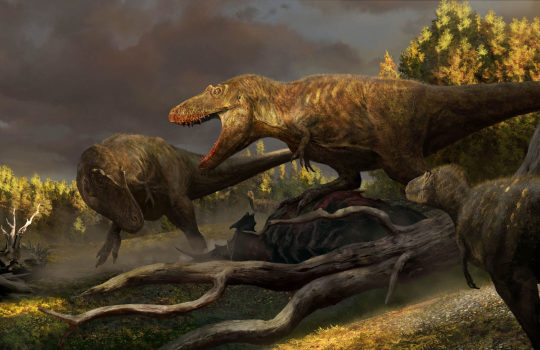
View On WordPress
0 notes